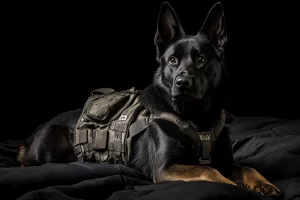Why A Home Protection Dog With a True Working Line German Shepherd Pedigree Is The Only Option
When considering a dog for home protection, few breeds are held higher esteem thank working line German Shepherds (GSDs). By this we do not mean show line GSDs, but true, proven working line dogs. As this article will demonstrate, working line German Shepherds from proven titled pedigrees nearly always make some of the best dogs for home protection work. Choosing a working line German Shepherd puppy for sale from a breeder committed to working lines will in most every situation make the most sense for anyone wanting a home protection dog. Here at Czech Working Line, we only raise working line GSDs. Every working line German Shepherd puppy for sale we offer will be sired by an IGP (Schutzhund) titled male. On both sides of the pedigree virtually every dogs on both mom and dad’s pedigree will be IGP titled, with many qualifying for the elite status of IGP 2 and IGP 3 titles.
Highly Trainable
The exceptional trainability of working line German Shepherds is well-known and important for any home protection dog. Working line German Shepherds are chosen for their quick learning abilities and obedience, in contrast to show line German Shepherds that are usually bred for their appearance (Helton, 2009). Their high level of trainability makes it easier to teach them how to perform protective tasks, enabling them to react quickly and accurately in dangerous situations.
Studies have demonstrated that working line German Shepherds have superior cognitive abilities in comparison to other breeds, leading them to be favored for roles in police, military, and home protection (Jones & Gosling, 2005). Their cleverness enables them to learn intricate commands rapidly, making them dependable in intense situations, a crucial aspect for efficient home security.
Selected for Genetic Predisposition for Protection Work
Opting for a working line German Shepherd has a major benefit in their innate protective instincts. These dogs have been selectively bred over many generations for the purpose of guarding and protecting, leading to a natural instinct to protect their space and loved ones (Serpell & Duffy, 2014). Working line German Shepherds have a natural instinct to protect their home and family, unlike other breeds that require intensive training to develop protective behaviors.
Research done by Svartberg in 2005 found that working line German Shepherds show high levels of traits linked to protectiveness and alertness in comparison to other dog breeds. This innate instinct allows them to rapidly recognize possible dangers and react, even with minimal training. Their protective instinct enhances their reliability and effectiveness as guard dogs for the home.
Innate Confidence in High Stress Situations
German Shepherds bred for work display significant levels of self-assurance and bravery, qualities necessary for a guard dog in a household. Confidence ensures the dog is not easily scared or discouraged by threats, while courage enables them to face dangers directly when needed. These characteristics are especially crucial in high-stress environments, as any hesitation or fear may hinder the dog’s capacity to safeguard its family.
German Shepherds bred from working lines are intentionally developed to possess a well-rounded temperament that blends courage with wise decision-making. This reduces the chances of them reacting aggressively due to fear and increases the likelihood of them evaluating and responding effectively to possible dangers. Their sense of assurance, along with their nurturing instincts, makes them an outstanding option for safeguarding the home (Arhant et al., 2010).
Bond With Owners
German Shepherds bred for work are recognized for developing strong connections with their owners, a crucial characteristic for a guard dog in any household. Their strong commitment to protecting family members guarantees they will go above and beyond, making them exceptionally devoted guardians (Haverbeke et al., 2010). The strong connection between the dog and its owner comes not just from training, but also from their genetic heritage developed through selective breeding in the working line.
Research conducted by Kubinyi et al. (2007) revealed that German Shepherds rank high in terms of bonding and sensitivity towards their owners, demonstrating a heightened awareness of their family members’ emotions and requirements. Their increased sensitivity enables them to quickly respond to environmental changes, making them very adept at detecting potential dangers to their residence and loved ones.
A Force of Nature: Boundless Stamina and Strength
A crucial aspect of a home security dog is its level of physical strength and endurance. German Shepherds in the working line are specifically bred for their physical fitness and endurance, allowing them to excel in tasks that require a lot of physical activity (Wilsson & Sundgren, 1997). Their strong physique and nimbleness allow them to chase trespassers, conquer dangers, and sustain a consistent level of energy for long durations, which is crucial for successful home security.
Working line German Shepherds are known for their stamina and physical ability for protection work, unlike other breeds that may easily tire or lack the necessary strength. Their combination of physical abilities and intelligence makes them a perfect option for families looking for a dog that can effectively guard their home from intruders.
Attentive and Vigilant Dogs
Another factor in selecting a working line German Shepherd for home defense is their remarkable vigilance and attentiveness. These dogs have been specifically bred to be watchful, always keeping an eye out for possible dangers in their environment (Mehrkam & Wynne, 2014). This increased level of alertness enables them to promptly identify any unusual behavior, notifying their owners of possible risks before they worsen.
Such a high level of vigilance is particularly important for home security, as spotting potential dangers early on can mean the difference between being safe and being at risk. German Shepherds bred for working are not just fast at detecting environmental changes, but they can also differentiate between typical and questionable behavior, which enhances their ability to spot real threats.
Conclusion
German Shepherds bred for work excel in protection tasks, solidifying their reputation as one of the most dependable breeds for safeguarding homes. For many years, they have been the preferred breed for police and military tasks, displaying excellence in positions that demand bravery, power, and smarts. Their ability to excel in these challenging roles proves that they are well-suited for guarding homes, having the required skills and temperament to navigate difficult circumstances effectively.
Research has indicated that German Shepherds excel over other breeds in protective and working duties, establishing them as a popular selection for those in need of a reliable companion for their home (Lindberg et al., 2015). Opting for a dog from a working line pedigree means you are picking a pet with a track record of success in protection work, giving assurance that your household and loved ones are in competent care.The top-notch trainability, natural protective instincts, confidence, loyalty, physical strength, alertness, and proven history in protection roles make working line German Shepherds unparalleled for home protection. Selecting a German Shepherd from a working line heritage guarantees a dog that has been carefully bred to be highly skilled in protection and security, safeguarding your family and residence. Their distinct blend of characteristics makes them a perfect option for households seeking a dependable and efficient guard dog. As you search for a working line German Shepherd puppy for sale, reach out to us with questions. We love to talk GSDs. To see if we have a working line German Shepherd puppy for sale that might fit your needs, click here.
Bibliography
- Arhant, C., Bubna-Littitz, H., Bartels, A., Futschik, A., & Troxler, J. (2010). Behaviour of smaller and larger dogs: Effects of training methods, inconsistency of owner behaviour and level of engagement in activities with the dog. Applied Animal Behaviour Science, 123(3-4), 131-142.
- Foyer, P., Bjällerhag, N., Wilsson, E., & Jensen, P. (2016). Behaviour and experiences of dogs during the first year of life predict the outcome in a later temperament test. Applied Animal Behaviour Science, 181, 72-77.
- Haverbeke, A., Laporte, B., Depiereux, E., Giffroy, J. M., & Diederich, C. (2010). Training methods of military dog handlers and their effects on the team’s performances. Applied Animal Behaviour Science, 125(1-2), 51-60.
- Helton, W. S. (2009). Cephalization, information processing, and dog intelligence. Behavioural Processes, 80(3), 291-301.
- Jones, A. C., & Gosling, S. D. (2005). Temperament and personality in dogs (Canis familiaris): A review and evaluation of past research. Applied Animal Behaviour Science, 95(1-2), 1-53.
- Kubinyi, E., Turcsán, B., & Miklósi, Á. (2007). Dog and owner demographic characteristics and dog personality trait associations. Behavioural Processes, 76(3), 320-325.
- Lindberg, S., Storsveen, A. B., & Løken, T. (2015). The effect of breed, handler and year on success rates of German Shepherds and other breeds in police dog work. Applied Animal Behaviour Science, 164, 64-75.
- Mehrkam, L. R., & Wynne, C. D. L. (2014). Behavioral differences among breeds of domestic dogs (Canis lupus familiaris): Current status of the science. Applied Animal Behaviour Science, 155, 12-27.
- Serpell, J. A., & Duffy, D. L. (2014). Dog breed differences in aggression. Applied Animal Behaviour Science, 152, 91-100.




